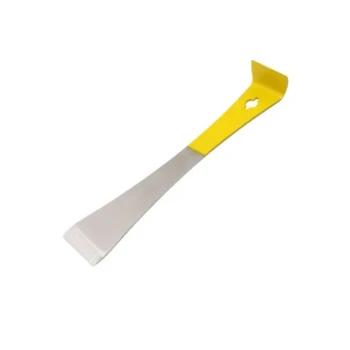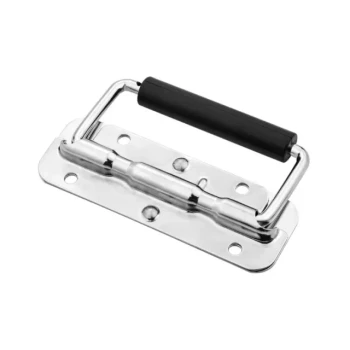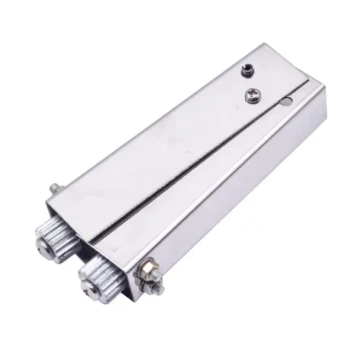In beekeeping, a level hive stand is critical for two primary reasons: it ensures the bees build straight, manageable comb inside the frames, and it provides the structural stability needed to prevent a catastrophic tip-over. Ignoring levelness creates significant, and often irreversible, problems for both the bees and the beekeeper.
A hive that is not level forces a conflict between the man-made hive box and the bees' natural, gravity-led construction. This misalignment is the root cause of structural comb problems that make hive management difficult and stressful.

The Foundation of Hive Management: Aligning with Bee Biology
The most critical reason for a level hive has to do with the fundamental way bees build their home. They do not use the walls of the hive as a guide; they use the pull of gravity.
Gravity and Comb Construction
Bees are masters of structural engineering, and they use an internal sense of gravity to draw every sheet of honeycomb perfectly plumb, or vertically straight. This instinct ensures their comb is strong and spatially efficient.
The Problem of Angled Comb
When you place a hive box on an unlevel surface, the bees ignore the tilt of the box. They still build their comb straight down in relation to gravity. This means the comb is now built at an angle relative to the removable frames.
Cross-Combing and Brace Comb
This angled construction quickly leads to cross-combing, where a single sheet of wax is attached across multiple frames. Bees may also attach the comb to the hive walls, creating what is known as brace comb. This effectively "welds" the internal components of the hive together.
The Impact on Inspections
For the beekeeper, this creates a nightmare. A simple hive inspection becomes impossible. Attempting to pull a single frame that is attached to its neighbors will tear apart delicate comb, destroy bee larvae, spill honey, and risk crushing or "rolling" the queen, which can doom the entire colony.
Ensuring Structural Integrity and Safety
Beyond the internal structure, levelness is a matter of basic physics and safety, especially as the hive grows.
The Physics of a Tall Stack
A beehive is a vertical stack of boxes that can easily weigh hundreds of pounds when full of honey and bees. A small tilt at the base becomes significantly amplified at the top of this tall, heavy column.
Risk of Tipping
An unlevel hive is inherently unstable. It is far more susceptible to being tipped over by strong winds, a curious animal like a raccoon or bear, or even an accidental bump from a lawnmower or the beekeeper. A fall can shatter the hive and destroy the colony.
Understanding the Trade-offs: Level vs. Slightly Pitched
While the principle of levelness is crucial, there is a professional nuance that separates a good setup from a great one. The key is understanding the difference between side-to-side and front-to-back orientation.
Side-to-Side Levelness is Non-Negotiable
For all the comb-building reasons mentioned above, a hive must be perfectly level from side to side. This is the axis that has the greatest impact on whether bees build comb correctly within their frames. There is no acceptable trade-off here.
The Exception: A Slight Forward Tilt for Drainage
Many experienced beekeepers intentionally make the hive slightly unlevel from front to back. By setting the stand so the back is about a half-inch higher than the front, you create a gentle slope. This encourages any rainwater that blows into the entrance or condensation that forms inside to drain out rather than pooling on the bottom board, which prevents rot and mold.
The Impact on Foundationless Frames
These principles are even more critical when using foundationless frames. Without a plastic or wax foundation sheet to guide them, the bees rely entirely on gravity. A hive that is not perfectly level side-to-side will almost guarantee a tangled mess of cross-comb in a foundationless setup.
Making the Right Choice for Your Setup
Setting up your hive stand correctly from the start is one of the most effective actions you can take to ensure your bees thrive and your management tasks remain easy.
- If your primary focus is easy hive inspections: Prioritize perfect side-to-side levelness to ensure bees build straight, manageable comb within the frames.
- If your primary focus is protecting the hive from weather: Implement a slight forward tilt (back higher than the front) only after you have achieved perfect side-to-side levelness to promote water drainage.
- If you are using foundationless frames: Treat perfect side-to-side levelness as an absolute, non-negotiable requirement to prevent chaotic and unmanageable cross-combing.
Properly leveling your hive is a simple, foundational step that prevents significant problems and sets your colony up for long-term success.
Summary Table:
| Aspect | Why It Matters | Key Takeaway |
|---|---|---|
| Comb Construction | Bees build comb straight down using gravity. | A level hive ensures comb is built within frames, not cross-combed. |
| Hive Inspections | Straight comb allows for easy frame removal. | Prevents tearing comb, killing brood, and harming the queen. |
| Structural Stability | A level base supports a tall, heavy hive stack. | Reduces the risk of the hive being tipped over by wind or animals. |
| Drainage (Tilt Exception) | A slight forward tilt helps water drain out. | Prevents moisture buildup and rot; only after side-to-side is level. |
Ensure your apiary's success from the ground up with HONESTBEE.
A properly designed hive stand is the foundation of productive beekeeping. For commercial apiaries and distributors, managing hundreds of hives means efficiency and reliability are paramount. HONESTBEE supplies durable, precisely engineered beekeeping equipment and supplies through wholesale-focused operations, helping you build stable, manageable hives that maximize honey production and minimize labor.
Contact HONESTBEE today to discuss your wholesale supply needs and build a stronger foundation for your business.
Visual Guide

Related Products
- Plastic Bee Hive Stand for Beekeeping
- Metal Hive Feet Bee Hive Stand for Ant Protection
- Professional Engraved Round Hive Number Tags for Beekeeping
- Metal Bee Hive Stand Bee Box Stand for Beekeeping
- Wholesales Dadant Size Wooden Bee Hives for Beekeeping
People Also Ask
- What are the main differences between Langstroth and Top Bar Hive designs? Choose the Right Hive for Your Beekeeping Goals
- How do bees regulate the temperature of their hive during the summer? Discover Their Natural Cooling System
- Why is elevating the hive important? A Simple Step for a Healthier, More Productive Colony
- What is the purpose of a hive stand in a Langstroth hive? Protect Your Hive and Boost Colony Health
- How do bees regulate ventilation and temperature in the hive? Master Hive Climate Control



















